

Cooley Hair Center
Personalized hair loss treatment plans that include medicated products and cutting-edge treatments. Jerry E. Cooley, M.D. and his team attract patients from around the U.S. and internationally due to his reputation for personalized care and ultra-natural results.
Cooley Hair Center. Hair Cloning & Research. Besides implanting cultured cells, another way to achieve a cloning effect is to stimulate hair follicle regeneration in the scalp.

This technique has become a practical reality with the advent of bio-active proteins to stimulate tissue regeneration. Dr. Cooley has also been on the forefront of this research, working with New York hair transplant surgeon Gary Hitzig, M.D. who developed the autocloning technique. Three Hair FolliclesTissue engineering research has discovered that implanting certain compounds can trigger the body to regenerate normal tissue at the site of injury. Another variation of the autocloning technique is to use plucked hairs to stimulate hair follicle regeneration. Have become depleted. Hair Loss Information. Is a reference that can be confusing and misleading.

It means that hair follicles are absent from microscopic scarring within the scalp. In non-scarring alopecia, even though hair shafts have been lost, the hair follicles are still present within the skin. In scarring alopecia, inflammation or trauma has resulted in the actual destruction of hair follicles and may or may not be associated with visible scars on the surface of the scalp. Types of scarring alopecia include Lupus, Lichen planopilaris, Frontal Fibrosing Alopecia, Central Centrifugal Cicatricial Alopecia (CCCA), as well as scarring from accidents, burns, or radiation treatment for cancer.
Hair Transplants for Women - Cooley Hair Center. When we think about hair loss, we usually picture a man with a receding hairline or a bald spot on the crown of his head.
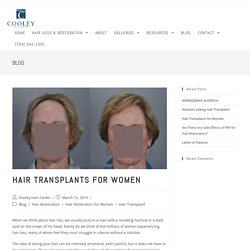
Rarely do we think of the millions of women experiencing hair loss, many of whom feel they must struggle in silence without a solution. The idea of losing your hair can be intensely emotional, even painful, but it does not have to be permanent. How Successful is PRP for Hair Restoration? - Cooley Hair Center. If you struggle with hair loss and have spent any time researching the latest developments in hair restoration, then you have likely heard of platelet-rich plasma (PRP) therapy.

PRP has been used for years to accelerate healing for orthopedic and cardiac surgery but has recently entered the cosmetic scene as a skin care and hair restoration treatment. With its recent emergence in the realm of hair loss, studies are still underway regarding PRP’s efficacy and its place in a comprehensive hair care routine for those struggling with genetic hair loss. At Carolina Hair Center, we are proud to offer this new and exciting treatment to our patients interested in the latest procedures.
FUE vs. FUT for My Hair Transplant - Cooley Hair Center. Navigating your way through the confusing and sometimes deceptive world of hair restoration can be a difficult process to do on your own.
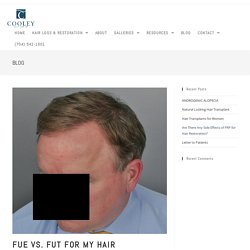
Many companies push products that do not work or outright claim to “cure” hair loss without FDA approval or reputable clinical trials. Once you finally weed through all of the outrageous claims and false promises to figure out what reliable treatments are actually available, understanding the dense and complicated language surrounding hair restoration can make the process even more difficult. Does a Vitamin Deficiency Cause Hair Loss? - Cooley Hair Center. Keeping your hair thick and healthy requires a constant supply of vitamins and nutrients stemming from a well-rounded diet.
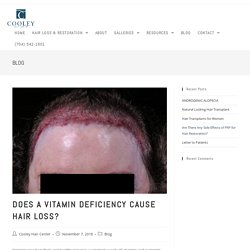
Consuming a diet that lacks the vital nutrients your body needs can lead to numerous health issues, but can a vitamin-deficient diet directly lead to hair loss? Do PRP Injections Help Combat Alopecia? - Cooley Hair Center. With millions of men and women experiencing the unwanted effects of age-related hair loss, the market for a hair loss cure is higher than ever.
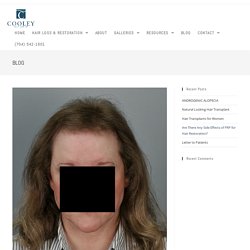
While research into a lifelong solution is still ongoing, recent advancements in hair restoration have led experts like Dr. Are There Any Side Effects Of PRP For Hair Restoration? Platelet-rich plasma (PRP) therapy is quickly becoming a buzz term in the world of hair restoration.
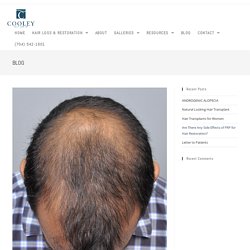
While it may sound daunting or complicated, PRP therapy is actually a simple and nonsurgical treatment approach that does not use any synthetic products. With minimal side effects, no downtime and proven results for many patients, PRP therapy is a safe and valuable treatment option for both men and women struggling with hair loss. At Cooley Hair Center, Dr. Natural Looking Hair Transplant - Cooley Hair Center. For as long as humans have been losing hair, we’ve been searching for ways to keep it.
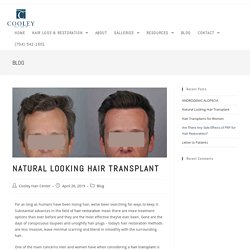
Substantial advances in the field of hair restoration mean there are more treatment options than ever before and they are the most effective they’ve ever been. Gone are the days of conspicuous toupees and unsightly hair plugs – today’s hair restoration methods are less invasive, leave minimal scarring and blend in smoothly with the surrounding hair. One of the main concerns men and women have when considering a hair transplant is whether their results will look natural. The answer is yes, it’s absolutely possible to achieve natural-looking hair restoration with modern techniques, provided you keep the following key considerations in mind.
Platelet Rich Plasma Therapy. Hair Transplant Result Videos. Before & After Photo Gallery. About Hair Transplant. Dr.
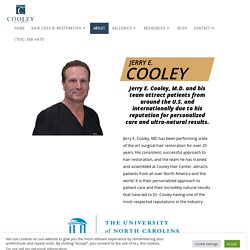
Cooley is also a past President of the International Society of Hair Restoration Surgery (ISHRS) and a diplomate of the American Board of Hair Restoration Surgery (ABHRS). He was the recipient of the ISHRS Platinum Follicle Award in recognition of his many scientific contributions to the field. Dr. Cooley is an in demand lecturer worldwide on the topics of hair restoration and regenerative medicine and has authored scientifically reviewed articles and textbook chapters regarding stem cell treatments, cloning, and surgical hair restoration techniques. Dr. Dr. Follicular Unit Transplantation. The patient is given a sedative and usually sleeps through the strip removal process.
The scalp is first numbed using local anesthesia at the start of the FUT procedure, ensuring patients remain comfortable and feel no pain or discomfort throughout the treatment. Once the patient has been numbed, Dr. Cooley removes a strip of the scalp from either the back or side of the head. FUE Hair Transplant. Hair transplants do not provide instant results, and patients should not expect to see an immediate improvement in their hair following surgery. In fact, the newly-transplanted hair will fall out about two to three weeks into recovery. The shedding is a natural part of the process and is expected.
New hair growth will begin around the two- to three-month mark, although a visible change will not be truly noticeable until six months following surgery. Because FUE does not require incisions, scarring is virtually nonexistent following the procedure. The handheld punch device may leave behind small circular scabs, but they will gradually fade into nearly invisible faint marks once the scalp has finished healing. Patients will experience a significant improvement in their hair density in about six months, although new hair growth will continue to improve for up to 18 months. Hair Transplant Surgery in Charlotte, NC. The processes behind hair transplant procedures are relatively straightforward. Hair transplantation works by harvesting healthy donor hair follicles and transplanting them to the areas of the scalp where the hair follicles have died out.
Hair grows naturally in groupings of one to four hairs, referred to as follicular units. During modern hair transplant procedures, viable follicular units are harvested from active parts of the scalp, known as the donor sites. The follicular units are then transplanted to rebuild thinning hairlines and fill in bald patches. While women tend to suffer from diffuse hair loss that occurs across the entire scalp, most men only lose hair from the tops of their heads and generally bald to a more significant degree than women. Hair Loss Medical Treatment.
Rogaine’s active ingredient is minoxidil, a medication initially used to treat high blood pressure. When doctors noticed that their patients also experienced unexpected and increased hair growth, its pivotal role as a treatment for hair loss was discovered. PRP Therapy for Hair Restoration in NC. When used as part of a comprehensive hair restoration treatment plan, PRP therapy can successfully minimize hair loss. The nutrient-rich plasma rejuvenates aging follicles and can reinvigorate thinning areas of the scalp to produce thicker hair. While PRP therapy cannot completely revive bald spots or rebuild hairlines, it can make a marked improvement in hair density and overall coverage, especially for patients with diffused hair loss. Results following PRP treatments are highly variable and may not be the same among all patients. Some patients can experience results that last for two years or longer, while others may need to schedule a second procedure to increase results.
Exosomes Therapy for Hair Loss. Exosomes are micro-vesicles, about 1/1000th the size of a normal cell, and are involved in normal intercellular communication. The exosomes in our treatment come from an FDA cleared biologics company that takes donated human mesenchymal stem cells, which are purified in the laboratory. To date, no complications or adverse events have been reported using this product in applications ranging from wound healing, orthopedics, anti-aging, and hair restoration. Mesenchymal derived exosomes are considered by many to be the most exciting new development in regenerative medicine. The unique benefit of these exosomes is that they are stem cell derived and bring a wide array of growth factors to stimulate the body’s own natural regenerative potential. When injected into the scalp, the result is thicker, healthier hair. The exosomes contain 200+ growth factors that are known to promote healing, regenerate normal tissue, and for our purposes, to thicken hair.